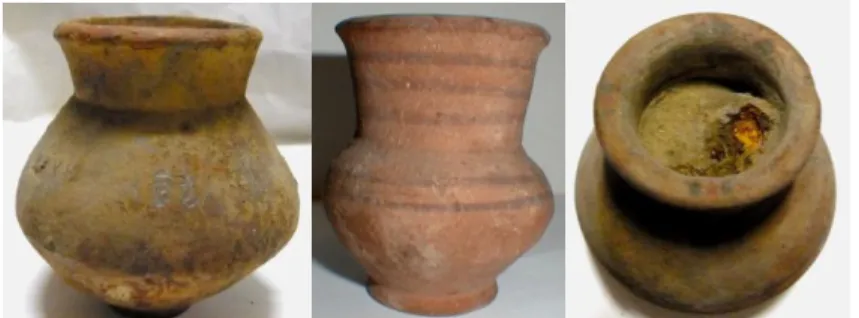HAL Id: insu-00786006
https://hal-insu.archives-ouvertes.fr/insu-00786006
Submitted on 7 Feb 2013HAL is a multi-disciplinary open access
archive for the deposit and dissemination of sci-entific research documents, whether they are pub-lished or not. The documents may come from teaching and research institutions in France or abroad, or from public or private research centers.
L’archive ouverte pluridisciplinaire HAL, est destinée au dépôt et à la diffusion de documents scientifiques de niveau recherche, publiés ou non, émanant des établissements d’enseignement et de recherche français ou étrangers, des laboratoires publics ou privés.
Molecular study of organic residues in an exceptional
collection of potteries from Deir el-Médineh (XVIIIth
dynasty, Egypt).
Claire Bastien, Armelle Charrié-Duhaut, Geneviève Pierrat-Bonnefois„
Jacques Connan, Claude Le Milbeau, Jorge E. Spangenberg
To cite this version:
Claire Bastien, Armelle Charrié-Duhaut, Geneviève Pierrat-Bonnefois„ Jacques Connan, Claude Le Milbeau, et al.. Molecular study of organic residues in an exceptional collection of potteries from Deir el-Médineh (XVIIIth dynasty, Egypt).. The 25th International Meeting on Organic Geochemistry, Sep 2011, Interlaken, Switzerland. 2p. �insu-00786006�
IMOG Abstract
Molecular study of organic residues in an exceptional
collection of potteries from Deir el-Médineh (XVIII
thdynasty, Egypt).
Claire Bastien1, Armelle Charrié-Duhaut1, Geneviève Pierrat-Bonnefois2, Jacques
Connan1, Claude Le Milbeau3, Jorge Spangenberg4
1Laboratoire de Biogéochimie Moléculaire (UMR 7177 CNRS et Université de Strasbourg), Strasbourg,
France, 2Département des Antiquités Egyptiennes (Musée du Louvre), Paris, France, 3Institut des Sciences
de la Terre d'Orléans (Université d'Orléans - INSU-CNRS), Orléans, France, 4Institute of Mineralogy and
Geochemistry, Lausanne, Switzerland (corresponding author:acharrie@unistra.fr)
Within this study of molecular archaeology, an exceptional set of Egyptian organic remains stored in containers from Deir el-Médineh (XVIIIth dynasty), and put at disposal by the Department of Egyptian Antiquities of the Louvre Museum has been analyzed. These containers, still full (Figure 1), were found in a necropolis located on the east side of the Valley of the Kings. This necropolis, excavated by Bernard Bruyère in 1933, was occupied by a population, who seemed to have a particular socio-cultural profile (Pierrat-Bonnefois, 2002). The identification of the complex organic mixtures, present inside the containers via the biomarkers analysis, may help to have some information about this population, and to understand their funeral rites.
Figure 1: Photographs of three containers (E16432, E14013 and E16446).
The molecular and isotopic study of a diversified sampling of these organic residues, based on chromatographic techniques and mass spectrometry (GC-MS, LC-MS and GC-C-irmMS), was carried out. Half of the analyzed samples contained about 40% of triglycerides which are indicators of a lipid base (animal fat or vegetable oil). Hydrolysis and oxidation products of triacylglycerols are detected (diacylglycerols, monoacylglycerols, free fatty acids, δ-lactones, γ-lactones,
α,ω-dicarboxylic acids, and dihydroxylated fatty acids). These results and the analysis of stable carbon isotopes of the methyl esters favoured plants over animals as the lipid source (Romanus, 2008). The presence of odd numbered n-alkanes, phytosterols and co-elutions of wax esters, has highlighted the complex mixtures with cuticular waxes of flowers or leaves (Ribechini, 2008). The absence of diagnostic terpenic structures excludes the use of natural resins. The others samples are characterized by the presence of degradation products of fatty material, but the triglycerides are not detected, which could indicate different preparation methods.
This investigation was completed by the study of fresh plant oils and of oils submitted to thermal degradation in order to determine their molecular fingerprint and the alteration products.
These containers seem to belong to the same family: ointments or cosmetics. They were used by the population of the necropolis but are they in relation with their profession or just offering for the eternity travel and their afterlife?
Pierrat-Bonnefois, G. (2002). Cimetière est du village ou cimetière à l’est de Deir el-Médineh?, Deir el-Médineh et la Vallée des Rois, colloque, Musée du Louvre, Edition Khéops-Musée du Louvre
Ribechini, E., Modugno, F., Colombini, M.P., Evershed, R.P. (2008). Gas chromatographic and mass spectrometric investigations of organic residues from Roman glass unguentaria. Journal of Chromatography A, 1183, 158-169.
Romanus, K., Van Neer, W., Marinova, E., Verbeke, K., Luypaerts A., Accardo, S., Hermans, I., Jacobs, P., De Vos, D., Waelkens, M. (2008). Brassicaceae seed oil identified as illuminant in Nilotic shells from a first millenium AD Coptic church in Bawit, Egypt. Anal Bioanal Chem, 390, 783-793.
